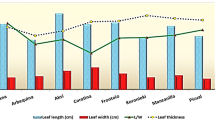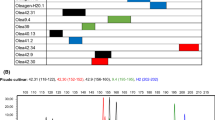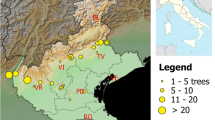Abstract
Olive is one of the most ancient crop plants and the World Olive Germplasm Bank of Cordoba (WOGBC), Spain, is one of the world’s largest collections of olive germplasm. We used 33 SSR (Simple Sequence Repeats) markers and 11 morphological characteristics of the endocarp to characterise, identify and authenticate 824 trees, representing 499 accessions from 21 countries of origin, from the WOGBC collection. The SSR markers exhibited high variability and information content. Of 332 cultivars identified in this study based on unique combinations of SSR genotypes and endocarp morphologies, 200 were authenticated by genotypic and morphological markers matches with authentic control samples. We found 130 SSR genotypes that we considered as molecular variants because they showed minimal molecular differences but the same morphological profile than 48 catalogued cultivars. We reported 15 previously described and 37 new cases of synonyms as well as 26 previously described and seven new cases of homonyms. We detected several errors in accession labelling, which may have occurred at any step during establishment of plants in the collection. Nested sets of 5, 10 and 17 SSRs were proposed to progressively and efficiently identify all of the genotypes studied here. The study provides a useful protocol for the characterisation, identification and authentication of any olive germplasm bank that has facilitated the establishment of a repository of true-to-type cultivars at the WOGBC.



Similar content being viewed by others
References
Badenes M, Garces A, Romero C, Romero M, Clave J, Rovira M, Llacer G (2003) Genetic diversity of introduced and local Spanish persimmon cultivars revealed by RAPD markers. Genet Resour Crop Evol 50:579–585
Baldoni L, Tosti N, Ricciolini C, Belaj A, Arcioni S, Pannelli G, Germana MA, Mulas M, Porceddu A (2006) Genetic structure of wild and cultivated olives in the central Mediterranean basin. Ann Bot 98:935–942
Baldoni L, Cultrera NG, Mariotti R, Ricciolini C, Arcioni S, Vendramin GG, Buonamici A, Porceddu A, Sarri V, Ojeda MA, Trujillo I, Rallo L, Belaj A, Perri E, Salimonti A, Muzzalupo I, Casagrande A, Lain O, Messina R, Testolin R (2009) A consensus list of microsatellite markers for olive genoty**. Mol Breed 24:213–231
Banilas G, Minas J, Gregoriou C, Demoliou C, Kourti A, Hatzopoulos P (2003) Genetic diversity among accessions of an ancient olive variety of Cyprus. Genome 46:370–376
Barranco D, Rallo L (1984) Las variedades de olivo cultivadas en Andalucia. Ministerio de Agricultura, Junta de Andalucia, Madrid, Spain
Barranco D, Cimato A, Fiorino P, Rallo L, Touzani A, Castañeda C, Serafini F, Trujillo I (2000a) World olive catalogue of olive varieties. International Olive Oil Council, Madrid, Spain
Barranco D, Trujillo I, Rallo L (2000b) Are ‘Oblonga’ and ‘Frantoio’ the same cultivar? HortSci 35:1323–1325
Barranco D, Trujillo I, Rallo L (2005) Elaiografía Hispanica. In: Rallo L, Barranco D, Caballero JM, Del Rio C, Martin A, Tous J, Trujillo I (eds) Variedades de olivo en España. Mundi-Prensa, Madrid
Bartolini G, Petrucelli R (2002) Classification, origin, diffusion and history of the olive. FAO, Rome
Bartolini G, Prevost G, Messeri C, Carignani C (2005) Olive germplasm: cultivars and world-wide collections. In: FAO SaPGRSo (ed) FAO
Belaj A, Satovic Z, Rallo L, Trujillo I (2002) Genetic diversity and relationships in olive (Olea europaea L.) germplasm collections as determined by randomly amplified polymorphic DNA. Theor Appl Genet 105:638–644
Belaj A, Caballero JM, Barranco D, Rallo L, Trujillo I (2003a) Genetic characterization and identification of new accessions from Syria in an olive Germplasm Bank by means of RAPD markers. Euphytica 134:261–268
Belaj A, Satovic Z, Ismaili H, Panajoti D, Rallo L, Trujillo I (2003b) RAPD genetic diversity of albanian olive germplasm and its relationships with other mediterranean countries. Euphytica 130:387–395
Belaj A, Satovic Z, Cipriani G, Baldoni L, Testolin R, Rallo L, Trujillo I (2003c) Comparative study of the discriminating capacity of RAPD, AFLP and SSR markers and of their effectiveness in establishing genetic relationships in olive. Theor Appl Genet 107:736–744
Belaj A, Munoz-Diez C, Baldoni L, Porceddu A, Barranco D, Satovic Z (2007) Genetic diversity and population structure of wild olives from the north-western Mediterranean assessed by SSR markers. Ann Bot 100:449–458
Belaj A, Dominguez-García MC, Atienza SG, Martín Urdíroz N, De la Rosa R, Satovic Z, Martín A, Kilian A, Trujillo I, Valpuesta V, Del Río C (2012) Develo** a core collection of olive (Olea europaea L) based on molecular markers (DArTs, SSRs, SNPs) and agronomic traits. Tree Genet Genomes 8:365–378
Besnard G, Breton C, Baradat P, Khadari B, Bervillé A (2001) Cultivar identification in the olive (Olea europaea L.) based onRAPDS. J Am Soc Hortic Sci 126:668–675
Besnard G, Khadari B, Navascués M, Fernández-Mazuecos M, El Bakkali A, Arrigo N, Baali-Cherif D, Brunini-Bronzini de Caraffa V, Santoni S, Vargas P, Savolainen V (2013) The complex history of the olive tree: from Late Quaternary diversification of Mediterranean lineages to primary domestication in the northern Levant. Proc R Soc B Biol Sci 280(1756)
Botstein D, White R, Skolnick M, Davis R (1980) Construction of a genetic-linkage map in man using restriction fragment length polymorphisms. Am J Hum Genet 32:314–331
Bowers JE, Dangl GS, Vignani R, Meredith CP (1996) Isolation and characterization of new polymorphic simple sequence repeat loci in grape (Vitis viniferaL.). Genome 39(4):628–633
Bracci T, Sebastiani L, Busconi M, Fogher C, Belaj A, Trujillo I (2009) SSR markers reveal the uniqueness of olive cultivars from the Italian region of Liguria. Sci Hortic 122:209–215
Caballero JM, del Rio C, Barranco D, Trujillo I (2006) The Olive World Germplasm Bank of Cordoba, Spain. Olea 25:14–19
Cantini C, Cimato A, Autino A, Redi A, Cresti M (2008) Assessment of the Tuscan olive germplasm by microsatellite markers reveals genetic identities and different discrimination capacity among and within cultivars. J Am Soc Hortic Sci 133:598–604
Carriero F, Fontanazza G, Cellini F, Giorio G (2002) Identification of simple sequence repeats (SSRs) in olive (Olea europaea L.). Theor Appl Genet 104:301–307
Charafi J, El Meziane A, Moukhli A, Boulouha B, El Modafar C, Khadari B (2008) Menara gardens: a Moroccan olive germplasm collection identified by a SSR locus-based genetic study. Genet Resour Crop Evol 55:893–900
Cipriani G, Marrazzo MT, Marconi R, Cimato A, Testolin R (2002) Microsatellite markers isolated in olive (Olea europaea L.) are suitable for individual fingerprinting and reveal polymorphism within ancient cultivars. Theor Appl Genet 104:223–228
Cipriani G, Marrazzo MT, Di Gaspero G, Pfeiffer A, Morgante M, Testolin R (2008) A set of microsatellite markers with long core repeat optimized for grape (Vitis spp.) genoty**—art. no. 127. BMC Plant Biol 8:127–127
Corrado G, La Mura M, Ambrosino O, Pugliano G, Varricchio P, Rao R (2009) Relationships of Campanian olive cultivars: comparative analysis of molecular and phenotypic data. Genome 52:692–700
Dakin EE, Avise JC (2004) Microsatellite null alleles in parentage analysis. Heredity 93(5):504–509
de la Rosa R, James C, Tobutt KR (2002) Isolation and characterization of polymorphic microsatellite in olive Olea europaea L. and their transferability to other genera in the Oleaceae. Mol Ecol Notes 2:265–267
Dice LR (1945) Measures of the amount of ecologic association between species. Ecology 26:297–302
Díez CM, Trujillo I, Barrio E, Belaj A, Barranco D, Rallo L (2011) Centennial olive trees as a reservoir of genetic diversity. Ann Bot 108:797–807
Díez CM, Imperato A, Rallo L, Barranco D, Trujillo I (2012) Worldwide core collection of olive cultivars based on simple sequence repeat and morphological markers. Crop Sci 52:211–221
D’Imperio M, Viscosi V, Scarano MT, D’Andrea M, Zulo BA, Pilla F (2001) Integration between molecular and morphological markers for the exploitation of olivegermoplasm (Olea europaea). Sci Hortic 130:229–240
Downey G, Boussion J (1996) Authentication of coffee bean variety by near–infrared reflectance spectroscopy of dried extract. J Sci Food Agric 71(1):41–49
Erre P, Chessa I, Munoz-Diez C, Belaj A, Rallo L, Trujillo I (2010) Genetic diversity and relationships between wild and cultivated olives (Olea europaea L.) in Sardinia as assessed by SSR markers. Genet Resour Crop Evol 57:41–54
Evans KM, Patocchi A, Rezzonico F, Mathis F, Durel CE, Fernández-Fernández F, Boudichevskaia A, Dunemann F, Stankiewicz-Kosyl M, Gianfranceschi L, Komjanc M, Latuer M, Madduri M, Noordijk Y, Van de Weg WE (2011) Genoty** of pedigreed apple breeding meterial with a genome-covering set of SSRs: trueness-to-type of cultivars and their parentages. Mol Breed 28:535–547
FAO (2008) The Statistical Database (FAOSTAT). Food and Agriculture Organization of the United Nations (FAO), Rome
Fendri M, Trujillo I, Trigui A, Rodriguez-Garcia MI, Ramirez JDA (2010) Simple sequence repeat identification and endocarp characterization of olive tree accessions in a Tunisian germplasm collection. Hortscience 45:1429–1436
Ganopoulos IV, Kazantzis K, Chatzicharisis I, Karayiannis I, Tsaftaris AS (2011) Genetic diversity, structure and fruit trait associations in Greek sweet cherry cultivars using microsatellite based (SSR/ISSR) and morpho-physiological markers. Euphytica 181:237–251
Garcia MG, Ontivero M, Diaz Ricci JC, Castagnaro A (2002) Morphological traits and high resolution RAPD markers for the identification of the main strawberry varieties cultivated in Argentina. Plant Breed 121:76–80
Garcia-Diaz A, Oya R, Sanchez A, Luque F (2003) Effect of prolonged vegetative reproduction of olive tree cultivars (Olea europaea L.) in mitochondrial homoplasmy and heteroplasmy. Genome 46:377–381
Gil FS, Busconi M, Machado AD, Fogher C (2006) Development and characterization of microsatellite loci from Olea europaea. Mol Ecol Notes 6:1275–1277
González-Plaza JJ, Muñoz-Mérida A, Ortiz-Martín I, Domínguez-García MC, Martín-Urdíroz N, Diez-Muñoz C, Sánchez-Sevilla JL, Rallo L, Trujillo I, Belaj A, de la Rosa R, Trelles O, Valpuesta V, Beuzón CR (2011) Identification of molecular markers in olive tree for the analysis of agronomical traits. In: 4th International Conference for Olive Tree and Olive Products. OliveBioteq, Chania, Grecia
Haouane H, El Bakkali A, Moukhli A, Tollon C, Santoni S, Oukabli A, El Modafar C, Khadari B (2011) Genetic structure and core collection of the World Olive Germplasm Bank of Marrakech: towards the optimised management and use of Mediterranean olive genetic resources. Genetica, Amsterdam
International Union for the Protection of New Varieties of Plants. 1991. International convention for the protection of new varieties of plants of 2 December 1961, as revised at Geneva on 10 November 1972, on 23 October 1978 and on 19 March 1991. http://www.upov.int/en/publications. Accessed 6 February 2011
Irish BM, Goenaga R, Zhang DP, Schnell R, Brown JS, Motamayor JC (2010) Microsatellite fingerprinting of the USDA-ARS tropical agriculture research station cacao (Theobroma cacao L.) germplasm collection. Crop Sci 50:656–667
Khadari B, Breton C, Moutier N, Roger JP, Besnard G, Berville A, Dosba F (2003) The use of molecular markers for germplasm management in a French olive collection. Theor Appl Genet 106:521–529
Khadari B, Charafi J, Moukhli A, Ater M (2008) Substantial genetic diversity in cultivated Moroccan olive despite a single major cultivar: a paradoxical situation evidenced by the use of SSR loci. Tree Genet Genomes 4:213–221
Kimura T, Zhong Shi Y, Shoda M, Kotobuki K, Matsuta N, Hayashi T, Ban Y, Yamamoto T (2002) Identification of Asian pear varieties by SSR analysis. Breed Sci 52:115–121
Koehmstedt AM, Aradhya MK, Soleri D, Smith JL, Polito VS (2010) Molecular characterization of genetic diversity, structure, and differentiation in the olive (Olea europaea L.) germplasm collection of the United States Department of Agriculture. Genet Resour Crop Evol 58:519–531
Laucou V, Lacombe T, Dechesne F, Siret R, Bruno JP, Dessup M, Dessup T, Ortigosa P, Parra P, Roux C, Santoni S, Vares D, Peros JP, Boursiquot JM, This P (2011) High throughput analysis of grape genetic diversity as a tool for germplasm collection management. Theor Appl Genet 122:1233–1245
Liu KJ, Muse SV (2005) PowerMarker: an integrated analysis environment for genetic marker analysis. Bioinformatics 21:2128–2129
Marshall TC, Slate J, Kruuk LEB, Pemberton JM (1998) Statistical confidence for likelihood-based paternity inference in natural populations. Mol Ecol 7:639–655
Martín MA, Alvarez JB, Mattioni C, Cherubini M, Villani F, Martin LM (2009) Identificationand characterisation of traditional chestnut varieties of southern Spain using morphological and simple sequence repeat (SSRs) markers. Ann Appl Biol 154:389–398
Melchiade D, Foroni I, Corrado G, Santangelo I, Rao R (2007) Authentication of the ‘Annurca’ apple in agro-food chain by amplification of microsatellite loci. Food Biotechnol 21(1):33–43
Motilal L, Butler D (2003) Verification of identities in global cacao germplasm collections. Genet Resour Crop Evol 50:799–807
Motilal LA, Zhang DP, Umaharan P, Mischke S, Pinney S, Meinhardt LW (2011) Microsatellite fingerprinting in the International Cocoa Genebank, Trinidad: accession and plot homogeneity information for germplasm management. Plant Genet Resour-C 9:430–438
Mouly PP, Gaydou EM, Faure R, Estienne JM (1997) Blood orange juice authentication using cinnamic acid derivatives. Variety differentiations associated with flavanone glycoside content. J Agric Food Chem 45(2):373–377
Myles S, Boyko AR, Owens CL, Brown PJ, Grassi F, Aradhya MK, Prins B, Reynolds A, Chia JM, Ware D, Bustamante CD, Buckler ES (2011) Genetic structure and domestication history of the grape. Proc Natl Acad Sci U S A 108:3530–3535
Noormohammadi Z, Hosseini-Mazinani M, Trujillo I, Ratio L, Belaj A, Sadeghizadeh M (2007) Identification and classification of main Iranian olive cultivars using Microsatellite markers. Hortscience 42:1545–1550
Park SDE (2001) Trypanotolerance in West African Cattle and the Population Genetic Effects of Selection. University of Dublin
Rallo L (2005) Variedades de olivo en España: una aproximación cronológica. In: Rallo L, Caballero JM, Del Rio C, Martin A, Tous J, Trujillo I (eds) Variedades de olivo en España. Junta de Andalucia, MAPA and Ediciones Mundi-Prensa, Madrid
Rallo L, Barranco D, Castro-García S, Connor DJ, Gómez-del-Campo M, Rallo P (2013) High-density olive plantations. Hortic Rev 41:303–384
Riaz S, Garrison KE, Dangl GS (2002) Genetic divergence and chimerism within ancient asexually propagated winegrape cultivars. J Amer Hort Sci 127(4):508–514
Rohlf FJ (1998) NTSYS-pc. Numerical taxonomy and multivariate analysis system.Version 2.00. Exeter Software. Setauket, New York
Sarri V, Baldoni L, Porceddu A, Cultrera NGM, Contento A, Frediani M, Belaj A, Trujillo I, Cionini PG (2006) Microsatellite markers are powerful tools for discriminating among olive cultivars and assigning them to geographically defined populations. Genome 49:1606–1615
Sefc KM, Lopes S, Mendonca D, Dos Santos MR, Machado MLD, Machado AD (2000) Identification of microsatellite loci in olive (Olea europaea) and their characterization in Italian and Iberian olive trees. Mol Ecol 9:1171–1173
Shan F, Clarke HC, Plummer JA, Yan G, Siddique KHM (2005) Geographical patterns of genetic variation in the world collections of wild annual Cicer characterized by amplified fragment length polymorphisms. Theor Appl Genet 110:381–391
Soleri D, Koehmstedt A, Aradhya MK, Polito V, Pinney K (2010) Comparing the historic olive trees (Olea europaea L.) of Santa Cruz Island with contemporaneous trees in the Santa Barbara, CA area: a case study of diversity and structure in an introduced agricultural species conserved in situ. Genet Resour Crop Evol 57:973–984
Staub JE, Meglic V (1993) Molecular genetic markers and their legal relevance for cultivar discrimination: a case study in cucumber. HortTechnology 3(3)
This P, Lacombe T, Thomas MR (2006) Historical origins and genetic diversity of wine grapes, vol. 22 No. 9. Elsevier, Amsterdam
Trujillo I, Rallo L, Arus P (1995) Identifying olive cultivars by isozyme analysis. J Am Soc Hortic Sci 120:318–324
Trujillo I, Ojeda MA, Baldoni L, Belaj A (2006) Olive cultivar identification by means of microsatellites (SSR). Olea 25:24–27
van Hintum TJL, Brown AHD, Spillane C, Hodgkin T (2000) Core collections of plant genetic resources. IPGRI Technical bulletin, p 48
Wünsch A, Hormaza JI (2002) Molecular characterisation of sweet cherry (Prunus aviumL.) genotypes using peach [Prunus persica (L.) Batsch] SSR sequences. Heredity 89:56–63
Zhang DP, Mischke S, Johnson ES, Phillips-Mora W, Meinhardt L (2009) Molecular characterization of an international cacao collection using microsatellite markers. Tree Genet Genomes 5:1–10
Zine El Aabidine M, Charafi J, Grout C, Doligez A, Santoni S, Moukhli A, Jay-Allemand C, El Modafar C (2010) Construction of a genetic linkage map for the olive based on AFLP and SSR markers. Crop Sci 50(6):2291–2302
Zohary D, Spiegel-Roy P (1975) Beginnings of fruit growing in the old world. Science 187:319–327
Zulini L, Fabro E, Peterlunger E (2005) Characterisation of the grapevine cultivar Picolit by means of morphological descriptors and molecular markers. Vitis 44(1):35–38
Acknowledgements
This work was financially supported by the projects RF01-006 and RF-2009-00011-00-00 (INIA, the Ministerio de Ciencia e Innovación of Spain) and Oleagen (Fundación Genoma España, Junta de Andalucía and Corporación Tecnológica de Andalucía). The research carried out by I. Trujillo was partially performed during a sabbatical leave at the University of California, Davis, which was funded by the Ministerio de Educación of Spain. Programa Salvador de Madariaga, No. Ref. PR-2009-0527. The authors are grateful to Dr. Juan M. Caballero and to the late Dr. Carmen Del Río, successive curators of the WOGBC, for facilitating us to carry out this work.
Author information
Authors and Affiliations
Corresponding author
Additional information
Communicated by G. G. Vendramin
Rights and permissions
About this article
Cite this article
Trujillo, I., Ojeda, M.A., Urdiroz, N.M. et al. Identification of the Worldwide Olive Germplasm Bank of Córdoba (Spain) using SSR and morphological markers. Tree Genetics & Genomes 10, 141–155 (2014). https://doi.org/10.1007/s11295-013-0671-3
Received:
Revised:
Accepted:
Published:
Issue Date:
DOI: https://doi.org/10.1007/s11295-013-0671-3




